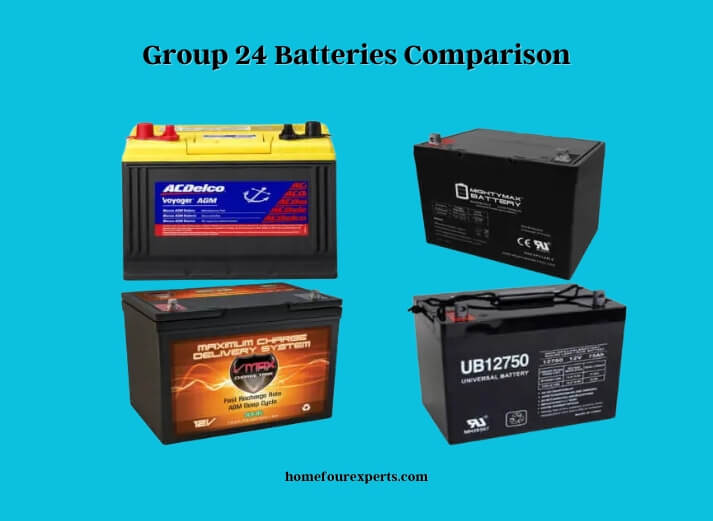Published on: May 5, 2022
Written by Liam Jaxon / Fact-checked by David Rowan
You may have heard terminology like “group 24 batteries” or “group 24f battery,” but what exactly are they? Batteries have a group number assigned by the Battery Council International (BCI). These numbers define the dimensions of the battery casing. Depending on the application, specific battery sizes are required. In cars, wheelchairs, and other industrial uses, BCI Group 24 batteries are widely encountered. They are utilized for deep cycle standby or float applications rather than starting or cranking batteries.

Your vehicle’s battery size, terminal positions, and type will determine your battery group size. Also, vehicle manufacture, model, and engine type affect group size. To find the group size, look at the battery that you’re replacing. The group size is frequently printed on the top or side labelling, especially if it is original equipment. If you are not sure overall then you can acknowledge the battery group size chart: how to choose your battery in this article.
This full article will cover all you have to know about Group 24 Batteries, including their most popular models. After reading the entire text, you will not be hesitant to choose the most appropriate battery group.
What Does Group 24 Mean on a Battery
In addition to deep-cycle float and standby, group 24 batteries can be employed as starters or dual-purpose batteries. Most group 24 batteries are L 10.25 x W 6.81 x H 8.88 inches. They are commonly found in AGM and SLA batteries and lithium-ion, gel-cell, and flooded batteries.
The physical dimensions of a battery dictate its group size. That doesn’t mean the greater the battery, the bigger the group. You’ll notice that a group 24 battery is ever-so-slightly larger than a group 51 battery, which measures L 9.37 x W 5.06 x H 8.81 inches compared to a group 51 battery.
Those who don’t know what vehicle takes a group 24 battery can notice that Acura, Honda, Infiniti, Lexus, Nissan, and Toyota cars are among the vehicles that take a group 24 battery. A large number of retailers will install the batteries at no cost to the customer.
Subgroups of Group 24 Battery
However, if the battery compartment can fit a Group 24 battery, it can usually fit a Group 24T battery as well. Because these mid-size batteries come in several subgroups of varying sizes, choosing the right one for the job is essential. The following groups are:
| BCI Group Size | L x W x H (inches) |
| 24 | 10 1/4 x 6 13/16 x 8 7/8 |
| 24F | 10 3/4 x 6 13/16 x 9 |
| 24H | 10 1/4 x 6 13/16 x 9 3/8 |
| 24R | 10 1/4 x 6 13/16 x 9 |
| 24T | 10 1/4 x 6 13/16 x 9 3/4 |
Features of Group 24 Battery
Group 24 battery is a must-have for any home due to its durability and reliability. But all group 24 batteries are not created equal. Below we recognize these features of a regular group 24 battery.
Chemistry
All batteries have the same basic structure such as grids and separators, with cell connectors enclosed in a tough polyethylene casing. But the 24 battery’s performance is all in the chemistry. As previously stated, group 24 batteries are chemically diverse. In terms of Group 24 battery chemistries, the following are the most common:
- Sealed Lead Acid
- Flooded Batteries
- AGM
Application
You can choose between starting, deep cycle, and dual-purpose batteries depending on your demands. Beginning batteries provide short bursts of electricity to an engine, starting and going out on the water quickly. On the other hand, deep cycle AGM batteries are engineered to run devices in nearly any condition.
Dually-purpose batteries are the answer if you want both but don’t have enough room in your car. It’s the least expensive, but it’s also the worst of the three possibilities. It may also need replacing more frequently.
AH Rating (Ah)
Consider your battery’s intended function. AH simply means how much current a battery can produce for an hour. The runtime increases with amp hour. 35Ah might be enough for minor applications. A 50Ah battery may not be enough if you plan to take it camping.
Durability
Longevity all depends on how often you use it. Manufacturers assess battery life in cycles rather than years. So, 24 Batteries with a lifespan of 1,000 cycles can be discharged and recharged 1,000 times before needing to be replaced. So a higher cycle is desirable.
Benefits of Using Group 24 Batteries
Group 24 batteries are typically used in automotive and marine applications because they are deep cycle batteries that have a large capacity and can provide a steady stream of power over a long period of time. Some benefits of using Group 24 batteries include:
- High capacity: Group 24 batteries have a capacity of around 75-85 amp-hours, which means they can provide a lot of power for a long period of time before needing to be recharged.
- Deep cycle capabilities: These batteries are designed to be discharged and recharged multiple times without suffering significant damage, making them well-suited for applications where the battery is regularly drained and recharged, such as powering a trolling motor on a boat.
- Vibration resistance: Group 24 batteries are built to withstand vibration and impact, which makes them well-suited for use in vehicles and boats where they are exposed to a lot of movement.
- Low maintenance: These batteries are sealed and maintenance-free, which means that they do not require regular water additions or other maintenance.
- Widely available: Group 24 batteries are common and widely available, making them easy to find and replace.
- Relatively affordable: Compared to some other types of batteries, Group 24 batteries are relatively affordable.
Risks Associated With Using Group 24 Batteries
Group 24 batteries are lead-acid batteries typically used in automotive and marine applications. Some risks associated with using these batteries include:
- Spillage: Lead-acid batteries can release electrolytes (a mixture of sulfuric acid and water) if tipped over or damaged, which can cause damage to the vehicle or injury to the user.
- Explosion: Lead-acid batteries can produce hydrogen gas while charging, which can lead to an explosion if there is an ignition source nearby.
- Corrosion: The sulfuric acid in the electrolyte can cause corrosion of the battery terminals and surrounding metal parts if not cleaned regularly.
- Maintenance: Lead-acid batteries require regular maintenance, such as checking and refilling the electrolyte level, cleaning the terminals, and ensuring proper charging.
- Short battery life: Lead-acid batteries typically have a shorter lifespan than other types of batteries, such as lithium-ion batteries.
It’s important to follow the manufacturer’s instructions for the proper use and handling of Group 24 batteries to minimize the risks.
Comparison Chart
BCI group 24 batteries are designed for the deep cycle or dual-purpose use. These batteries can store a lot of energy and deliver a lot of power, mainly when employed in low-power applications. Below mentioned batteries have their own chemistry, terminals, weight, charging, and characteristics.
| Model | Battery Type | Chemistry | Ah | Weight (lbs/kg) |
| NorthStar 24F Battery NSB-AGM24F | Dual Purpose | AGM | 76 | 57 lbs |
| Mighty Max BatteryESP25 | Dual Purpose | SLA / AGM | 75 | 50.71 lbs |
| ACDelco M24AGM Battery | Deep Cycle | AGM | 80 | 43.0 lbs |
| Universal Power Group UB12750 45821 | Deep Cycle | AGM | 75 | 49.1 lbs |
| VMAX SLR85 Group 24 | Deep Cycle | AGM | 85 | 55 lbs |
FAQs
1) What Is the Difference Between Group 24 and Group 27 Batteries?
Batteries of Group 27 are greater in size and are utilized for more efficient machinery. They can be found in various vehicles, including marine vessels, huge autos, and off-grid recreational vehicles. They have a 20-hour capacity and operate in the 66-110Ah range.
2) What Is the Difference Between a 24 and 24f Battery?
The polarity of these two batteries is what distinguishes them from one another. The polarity of the Group 24 battery is conventional; however, the polarity of the Group 24F battery is reversed.
Maintenance of Group 24 Batteries
Deep cycle AGM batteries, for instance, have a lifespan of five to ten years. This is owing to its maintenance-free and still-proof design.
Without adequate care, the battery may degrade considerably faster than intended. By following below basic maintenance guidelines, you can get the most out of your batteries.
Correctly Store It
Even the toughest materials can be harmed if not stored properly. Keep your 24 battery cool, dry, and ventilated. Remember to recharge it every three months since batteries self-discharge. Sulfation occurs if you leave it discharged. Sulphated batteries won’t work.
Avoid Over Or Below Charging
Overcharging your battery can cause internal damage. On the other hand, undercharging it will result in its death. To prolong the battery’s life, you must strike a balance. Follow the manufacturer’s instructions to find your battery’s voltage and use the manufacturer’s recommended charger.
Conclusion
The most excellent Group 24 battery can do many things. But, before you buy a battery for your car, it is wise to do your homework. Anyway, we hope our article cleared up any doubts and provided all the information you needed regarding group 24 batteries.
We’ve already covered the group 24 batteries comparison chart, features, and recommendations list of some better alternatives. Among them, we loved the features they provided. To avoid your vehicle stopping at every intersection, choose group 24 cells.
Read more:
About This Writer

Hi, I am responsible for the 'Homeowners Power Solutions' category. My name is Liam Jaxon and a licensed technician with 7 years of experience in vehicle batteries, electrical gadgets, and home appliances. My working experience in different residential & light commercial electrical sectors and the automobile industry helped to acquire vast knowledge in this industry.